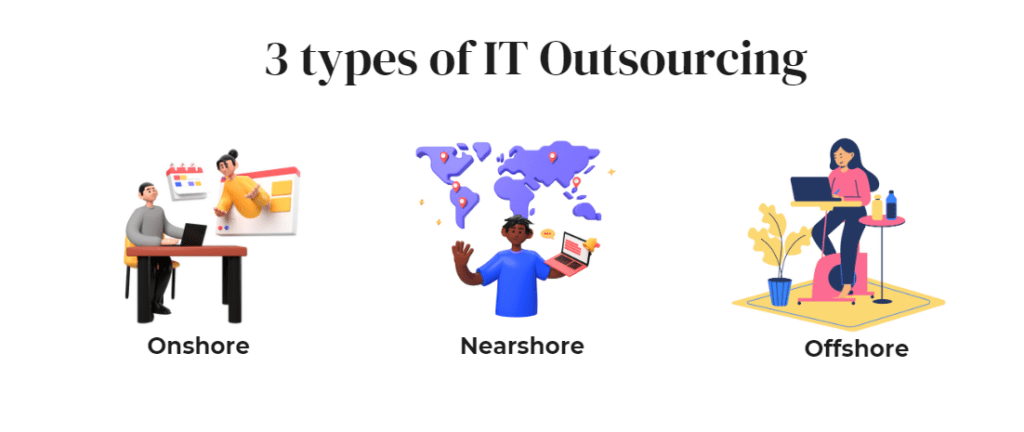Essential IT Outsourcing Guide: Best Practices for Success
27 Aug 2024 By: Mary Dellosa
Updated
In today’s busy business world, companies often outsource IT to stay competitive. By working with outside experts, they save money and focus on what they do best. But outsourcing can be tricky. This IT outsourcing guide guide shares simple tips to help your business handle challenges and get the best results.
What is IT Outsourcing?
Before exploring best practices in outsourcing project work, it’s crucial to understand IT outsourcing Services. In simple terms, it means hiring external experts to handle IT tasks. These tasks can include software development, network management, or technical support. By outsourcing, companies access specialized skills and resources, speeding up projects and boosting efficiency.
Outsourcing of IT Services isn’t the same for everyone. Companies can adjust it to fit their specific needs. Some go offshore to save money with teams in countries like India or the Philippines. Others choose nearshore outsourcing to work more easily with teams in closer time zones. Some prefer onshore outsourcing to support local businesses and keep things familiar.
Defining IT Outsourcing
IT outsourcing is when companies hire outside help to handle their tech needs, whether locally or overseas. It’s grown quickly thanks to better technology, a connected world, and the need to save money.
When companies outsource their IT tasks, they need to think carefully about things like data security, service agreements, and the provider’s reputation. Data security is key, especially with sensitive information. Service level agreements set clear expectations for both sides. Also, the provider’s reputation and history are important for a successful partnership.
Why do companies outsource?
Companies outsource for a few simple reasons:
- Save money: It’s often cheaper than hiring full-time staff.
- Get expert help: Outsourcing gives access to specialized skills that aren’t available in-house.
- Stay focused: It frees up time so companies can concentrate on what they do best.
- Grow easily: Outsourcing makes it easy to scale services as the business grows.
- Adopt new tech fast: It helps businesses quickly use the latest technology without managing it themselves.
These benefits help companies stay flexible, efficient, and competitive.
What IT Services can be outsourced?

Here are some common IT services you can outsource:
- Software development: Creating custom software or apps for your business by dedicated software developers who specialize in designing, coding, and optimizing applications tailored to your specific needs.
- Technical support: Handling customer or employee IT issues through a helpdesk.
- Network management: Keeping your business’s network running smoothly.
- Cybersecurity: Protecting your data from hackers and security threats.
- Cloud services: Managing cloud storage and systems for flexibility and growth, Often with the help of cloud service providers that offer scalable infrastructure and expert support.
- Data backup and recovery: Making sure your data is safe and can be recovered if something goes wrong.
- Physical security: Installing and maintaining access control hardware and devices such as smart locks, card readers, biometric scanners, and surveillance cameras to secure office spaces and control who can access sensitive areas.
- IT consulting: Getting expert advice on improving your tech setup.
- Website management: Taking care of your website’s updates, security, and performance.
Outsourcing these tasks helps you focus on what your business does best while experts handle the tech.
The Evolution of IT Outsourcing
IT outsourcing has changed from just a way to save money to a smart business choice. At first, companies used it mainly to cut costs. But over time, they saw it could do more. Today, outsourcing helps businesses access expert skills, spark new ideas, and stay competitive.
As technology rapidly advances, IT outsourcing keeps evolving too. Trends like cloud computing, AI, and automation are changing how IT services work. Companies now seek partners who offer the latest tech solutions, not just traditional outsourcing. This focus on innovation-driven outsourcing helps businesses transform digitally and stay ahead in a competitive world.
What are the three types of IT outsourcing?

Onshore outsourcing: This is when you hire a company within your own country to handle IT tasks. It’s great for easier communication and staying in the same time zone.
Offshore outsourcing: This involves working with a company in a different country, often to save money. This involves working with a Offshore Software Development Company in a different country, often to save money. While it’s usually cheaper, it can come with challenges like time zone differences or language barriers.
Nearshore outsourcing: You work with a company in a nearby country. It offers cost savings like offshore outsourcing but with fewer communication or time zone issues since the location is closer.
What are the Challenges of IT Outsourcing?
While IT outsourcing offers many benefits, it also brings challenges that companies must tackle to succeed. By recognizing these challenges early, businesses can reduce risks and make the most of outsourcing.
Identifying Common Problems on Outsourcing of IT Services
One common challenge organizations face is losing control and visibility over outsourced tasks. When key IT functions are handed to outside providers, it becomes harder to monitor and manage the work. This can lead to inefficiencies, delays, or disruptions in projects.
Additionally, maintaining strong communication with outsourcing partners can be tough. Cultural and language differences may cause misunderstandings and misaligned expectations. To overcome these challenges, companies need to set up clear communication channels and create a collaborative environment.
Another challenge is keeping data secure and protecting sensitive information. Outsourcing IT tasks often means sharing confidential data with external partners, which can risk privacy and compliance. For businesses exploring options like outsourcing mobile app development, selecting a trusted partner with proven expertise ensures both efficiency and security throughout the process. Companies must enforce strong security measures and set clear agreements to address these concerns. Regular audits and assessments are also crucial to ensure compliance with data protection rules and industry standards.
Mitigating Risks in IT Outsourcing
To reduce risks in IT outsourcing, businesses need solid vendor relationships. Start by picking the right partner who matches your company’s culture and has a good track record. Also, make sure you set clear expectations about performance, quality, and how to handle problems together. Mitigate IT outsourcing challenges with effective multi cloud data management strategies, ensuring seamless data integration, security and compliance across diverse cloud environments.
To stay safe, don’t rely on just one outsourcing partner. If something goes wrong, it could disrupt everything. Using multiple partners helps spread the risk and keeps things running smoothly. Regular communication with your outsourcing partner is key to success. Building a strong relationship and staying in touch helps both sides stay aligned and quickly solve problems. This means having regular check-ins, sharing feedback, and working together to improve.
Transitioning to Benefits: The Power of Effective IT Outsourcing
Though IT outsourcing has its challenges, it offers big benefits when managed well. With the right strategies, companies can fully tap into IT outsourcing and see real business results. The key to successful IT outsourcing is building good relationships with your partners. Regular check-ins, honest conversations, and setting goals together keep everyone on track and working toward the same goals.
The Role of Strategic Planning in IT Outsourcing
Effective IT outsourcing starts with a clear plan. Companies need to define their goals, decide which IT tasks to outsource, and consider how it will affect their team. By aligning outsourcing with their bigger business goals, companies can make it a strategic advantage instead of just a separate project.
Strategic planning should also focus on managing risks. It’s key to plan ahead for issues like data breaches or service interruptions. Setting up backup plans and recovery steps helps keep the business safe and running smoothly, even when things go wrong.
Ensuring Quality Control in Outsourced IT Services
Maintaining quality control is vital in IT outsourcing. Companies should set up strong systems to monitor and evaluate their partner’s performance. Regular audits, reviews, and comparisons can highlight areas for improvement and help ensure services get better over time.
It’s important to do more than just track performance. Encouraging new ideas in outsourced IT can help your business grow and stay ahead. By supporting creativity and problem-solving, you can get more from your outsourcing partners and keep up with the fast-changing tech world.
Best Practices for Successful IT Outsourcing
To make IT outsourcing work, start with the right partner. Check their background, past projects, and client reviews. Make sure they understand your goals and how your team works.
Set clear targets and timelines early. Keep communication open. Regular updates help avoid confusion and fix small issues fast.
Pick a provider that treats data security as a priority. Let your internal team work closely with them. It builds trust and keeps projects moving.
Track progress often. Share feedback and make small adjustments along the way. With the right setup, outsourcing saves money, reduces stress, and helps your business grow.
Choosing the Right IT Outsourcing Partner
Success in IT outsourcing starts with the right partner. Skills matter, but so does understanding your business. Work with a team that communicates clearly and shares your goals.
A good partner delivers on time and stays within budget. They adapt when plans change and keep things running smoothly. When your values align, trust builds. That’s what turns outsourcing into a long-term success.
Establishing Clear Communication Channels
Good communication is crucial for successful IT outsourcing. Regular check-ins, both for big goals and daily tasks, keep everyone aligned. Clear communication helps fix problems quickly and ensures the project moves forward smoothly.
Strong communication is the heart of successful outsourcing. Regular check-ins, updates, and feedback create trust and transparency. Open conversations help both sides handle problems quickly, make changes when needed, and keep the project on track.
Setting Realistic Expectations and Goals
Successful IT outsourcing starts with clear and honest goals. Both sides should agree on what needs to be done and when. Keep targets realistic so progress feels steady, not rushed.
When expectations are set early, everyone moves in the same direction. It prevents confusion and keeps projects on track. Clear goals and open communication make teamwork easier and results stronger.
The Future of IT Outsourcing
As technology keeps changing fast, the future of IT outsourcing brings both opportunities and challenges. Companies must stay on top of new trends and adapt quickly to stay competitive.
IT outsourcing is shaped by several transformative trends. AI-powered chatbots and Robotic Process Automation (RPA) drive operational efficiency by automating tasks and enhancing customer interactions. Cybersecurity outsourcing is also rising due to the increasing complexity of cyber threats, enabling companies to access specialized security expertise
Additionally, multi-cloud and hybrid cloud strategies allow businesses to optimize costs, scalability, and flexibility. As technology keeps changing fast, the future of IT outsourcing brings both opportunities and challenges, with cloud cost optimization strategies becoming increasingly important for managing resources efficiently. Industry-specific outsourcing and the adoption of 5G technology further push innovation, creating new opportunities across sectors
Emerging Trends in IT Outsourcing
IT outsourcing keeps changing. Businesses now have more options and can save more money.
Cloud services make it easier to scale. Instead of big upfront costs, companies pay only for what they use. It’s flexible and cost-efficient.
AI and automation handle routine tasks like sorting data or answering questions. That frees up teams to focus on bigger goals and make faster decisions.
Security is just as important. As more work moves online, protecting data is a must. Regular network security testing helps spot risks early and keeps information safe.
Why do companies outsource IT services?
To stay ready for future IT outsourcing changes, companies need to stay flexible and open to new ideas. This means regularly reviewing outsourcing strategies, embracing new tech, and helping employees learn new skills to keep up in a digital world.
FAQ
What’s the most important factor for successful IT outsourcing?
Choosing the right partner. It’s not enough that they have technical skills—they should also understand your business, fit your culture, and communicate clearly. helpsquad.com
Why do clear goals and expectations matter?
They keep everyone aligned. If both sides know what must be done, when, and how well, it reduces misunderstandings and helps track progress effectively.
How important is communication in outsourcing relationships?
It’s essential. Regular check-ins, honest feedback, and open dialogue build trust. They keep the project on track and allow early adjustments when things change.
What role does monitoring and feedback play?
A big one. Keeping an eye on progress, giving feedback, and making incremental improvements ensures the outsourcing arrangement continues to meet your needs and deliver value.
How should businesses prepare for the future of IT outsourcing?
By staying adaptable and aware of new trends—like cloud-based services, automation/AI, and advanced security needs. Being prepared means you can leverage the changes instead of being caught off guard.
Conclusion
In conclusion, IT outsourcing can help businesses grow. But it’s important to understand it and handle any challenges that come up. By staying smart and keeping up with new trends, companies can make the most of IT outsourcing and stay ahead in a changing world.
Ready to transform your business with strategic IT outsourcing? Look no further than HelpSquad BPO. Our dedicated virtual assistants and 24/7 customer service team are here to elevate your operations, offering bilingual support, back-office management, and research services at competitive rates starting from just $8.50 per hour. Don’t miss the opportunity to enhance your efficiency and stay ahead in the digital age. Talk to us today and experience the HelpSquad difference!
Optimize Your IT Outsourcing Strategy with HelpSquad
Building a successful outsourcing partnership requires expertise, communication, and trust. Let HelpSquad guide your organization through best practices to ensure your IT operations are efficient, secure, and cost-effective.


